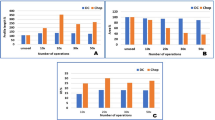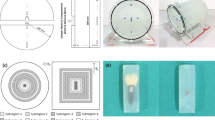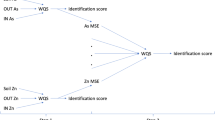Introduction
Posterior capsule rupture (PCR) rates are used to measure cataract surgeons’ quality. We wished to evaluate the internal non-visible surfaces of metal irrigation/aspiration (I/A) tips to identify potential mechanisms for PCR via novel metallographic imaging.
Methods
Ten metal I/A instruments underwent metallographic preparation by fine sectioning to expose inner surfaces near the aspiration opening. Analysis of inner bore, lumen, and opening aperture of metal aspiration tips was performed by optical microscopy, scanning electron microscopy (SEM), and 3D volume X-ray computational tomography (XCT). Distances from external aperture to first sharp metal surface were obtained and compared with a silicone-tipped instrument.
Results
We identified metal burrs near the aspiration apertures and manufacturing defects within all tips. XCT confirmed optical and SEM findings of significant defects and metal irregularities within aspiration tips. Samples also showed variation in lumen size/thickness, rough surfaces and material inhomogeneity, most pronounced at the internal tip. Median distance from outer aperture opening to first metal burr was 30 microns (range 10–120) and to internal tip irregularity (manufacturing flaw) was 250 microns (range 100–350). By comparison, distance to metal from the silicone outer aperture opening was 850 microns.
Conclusions
We have demonstrated the hidden sharp metallic irregularities within commonly used metal I/A tips. If an aspirated capsule encounters these sharp metal flaws, PCR could result. Minimising this risk would require lengthening potential distance between capsule and bare metal (as with polymer/silicone tips). Our study provides unique imaging evidence endorsing this principle and illustrates a hidden mechanism contributing to PCR.
Similar content being viewed by others
Log in or create a free account to read this content
Gain free access to this article, as well as selected content from this journal and more on nature.com
or
References
Qin VL, Conti FF, Singh RP. Measuring outcomes in cataract surgery. Curr Opin Ophthalmol. 2018;29:100–4.
Stein JD. Serious adverse events after cataract surgery. Curr Opin Ophthalmol. 2012;23:219–25.
Habib MS, Bunce CV, Fraser SG. The role of case mix in the relation of volume and outcome in phacoemulsification. Br J Ophthalmol. 2005;89:1143–6.
Johnston RL, Taylor H, Smith R, Sparrow JM. The Cataract National Dataset electronic multi-centre audit of 55,567 operations: variation in posterior capsule rupture rates between surgeons. Eye. 2010;24:888–93.
Day AC, Donachie PH, Sparrow JM, Johnston RL, Royal College of Ophthalmologists’ National Ophthalmology Database. The Royal College of Ophthalmologists’ National Ophthalmology Database study of cataract surgery: report 1, visual outcomes and complications. Eye. 2015;29:552–60.
Nderitu P, Ursell P. Updated cataract surgery complexity stratification score for trainee ophthalmic surgeons. J Cataract Refract Surg. 2018;44:709–17.
Kim BZ, Patel DV, McKelvie J, Sherwin T, McGhee CNJ. The Auckland cataract study II: reducing complications by preoperative risk stratification and case allocation in a teaching hospital. Am J Ophthalmol. 2017;181:20–25.
Ferris JD, Donachie PH, Johnston RL, Barnes B, Olaitan M, Sparrow JM. Royal College of Ophthalmologists’ National Ophthalmology Database study of cataract surgery: report 6. The impact of EyeSi virtual reality training on complications rates of cataract surgery performed by first and second year trainees. Br J Ophthalmol. 2020;104:324–9.
Jamison A, Benjamin L, Lockington D. Quantifying the real-world cost saving from using surgical adjuncts to prevent complications during cataract surgery. Eye. 2018;32:1530–6.
Barraquer RI, Michael R, Abreu R, Lamarca J, Tresserra F. Human lens capsule thickness as a function of age and location along the sagittal lens perimeter. Invest Ophthalmol Vis Sci. 2006;47:2053–60.
Cruz OA, Wallace GW, Gay CA, Matoba AY, Koch DD. Visual results and complications of phacoemulsification with intraocular lens implantation performed by ophthalmology residents. Ophthalmology. 1992;99:448–52.
Osher RH, Cionni RJ. The torn posterior capsule: its intraoperative behavior, surgical management, and long-term consequences. J Cataract Refract Surg. 1990;16:490–4.
Gimbel HV, Sun R, Ferensowicz M, Anderson Penno E, Kamal A. Intraoperative management of posterior capsule tears in phacoemulsification and intraocular lens implantation. Ophthalmology. 2001;108:2186–9.
Thanigasalam T, Sahoo S, Ali MM. Posterior capsule rupture with/without vitreous loss during phacoemulsification in a hospital in Malaysia. J Asia Pac J Ophthalmol. 2015;4:166–70.
Benjamin L. Fluidics and rheology in phaco surgery: what matters and what is the hype? Eye. 2018;32:204–9.
Docherty PT. A modified irrigating-aspirating needle. Br J Ophthalmol. 1988;72:368–9.
Dewey SH. Cortical removal simplified by J-cannula irrigation. J Cataract Refract Surg. 2002;28:11–4.
Hagan JC III. Irrigation/aspiration handpiece with changeable tips for cortex removal in small incision phacoemulsification. J Cataract Refract Surg. 1992;18:318–20.
Colvard DM. Bimanual technique to manage subincisional cortical material. J Cataract Refract Surg. 1997;23:707–9.
Brauweiler P. Bimanual irrigation/aspiration. J Cataract Refract Surg. 1996;22:1013–6.
Sakamoto T, Shiraki K, Inoue K, Yanagihara N, Ataka S, Kurita K. A simple, safe bimanual technique for subincisional cortex aspiration. Ophthalmic Surg Lasers. 2002;33:337–9.
Lockington D, Gavin MP. Intraoperative floppy-iris syndrome: role of the bimanual approach. J Cataract Refract Surg. 2009;35:964.
Reed-Miller C, Heslin K, Liebowitz S. Scanning electron microscopy of an irrigation/aspiration tip following a posterior capsular rupture. J Am Intraocul Implant Soc. 1985;11:391–2.
Blomquist PH, Pluenneke AC. Decrease in complications during cataract surgery with the use of a silicone-tipped irrigation/aspiration instrument. J Cataract Refract Surg. 2005;31:1194–7.
Maubon LG, Ursell PG. Reduced posterior capsular rupture rate observed among trainee surgeons utilizing a disposable silicone-tipped irrigation and aspiration handpiece for soft lens removal. Expert Rev Ophthalmol. 2018;13:293–7.
Temel M, Osher RH. Posterior capsule tear resulting from faulty instrumentation. J Cataract Refract Surg. 2003;29:619–20.
Barros MG, Osher RH. Posterior capsule tear caused by misalignment within a silicone irrigation/aspiration tip. J Cataract Refract Surg. 2004;30:1570–1.
Hart JC Jr, Tanner M, Rooney DM. Electron microscopy of silicone irrigation/aspiration tips involved in posterior capsule rupture. J Cataract Refract Surg. 2018;44:1517–20.
Lockington D, Macdonald E, Mantry S, Ramaesh K. A case for single-use disposable corneal forceps: equipment reliability should be the primary concern. Br J Ophthalmol. 2010;94:388–9.
Nakano CT, Motta AF, Hida WT, Nakamura CM, Tzelikis PF, Ruiz Alves M, et al. Hurricane cortical aspiration technique: one-step continuous circular aspiration maneuver. J Cataract Refract Surg. 2014;40:514–6.
Acknowledgements
A version of this paper is a free paper presentation at the (virtual) 38th ESCRS Congress in October 2020.
Author information
Authors and Affiliations
Corresponding author
Ethics declarations
Conflict of interest
Nil relevant to this work. DL has received educational and KOL honoraria from Alcon, Bausch & Lomb, Santen and Thea. AM, TM, FS: nothing to declare.
Consent for publication
Granted.
Additional information
Publisher’s note Springer Nature remains neutral with regard to jurisdictional claims in published maps and institutional affiliations.
Rights and permissions
About this article
Cite this article
Lockington, D., Macente, A., Marrocco, T. et al. Novel internal analysis of metal irrigation/aspiration tips could explain mechanisms of posterior capsule rupture. Eye 35, 1915–1921 (2021). https://doi.org/10.1038/s41433-020-01181-7
Received:
Revised:
Accepted:
Published:
Issue date:
DOI: https://doi.org/10.1038/s41433-020-01181-7
This article is cited by
-
Timing of posterior capsular rupture during cataract surgery
Eye (2025)
-
The Royal College of Ophthalmologists’ National ophthalmology database study of cataract surgery: Report 14, cohort analysis – the impact of CapsuleGuard® utilisation on cataract surgery posterior capsule rupture rates
Eye (2024)



